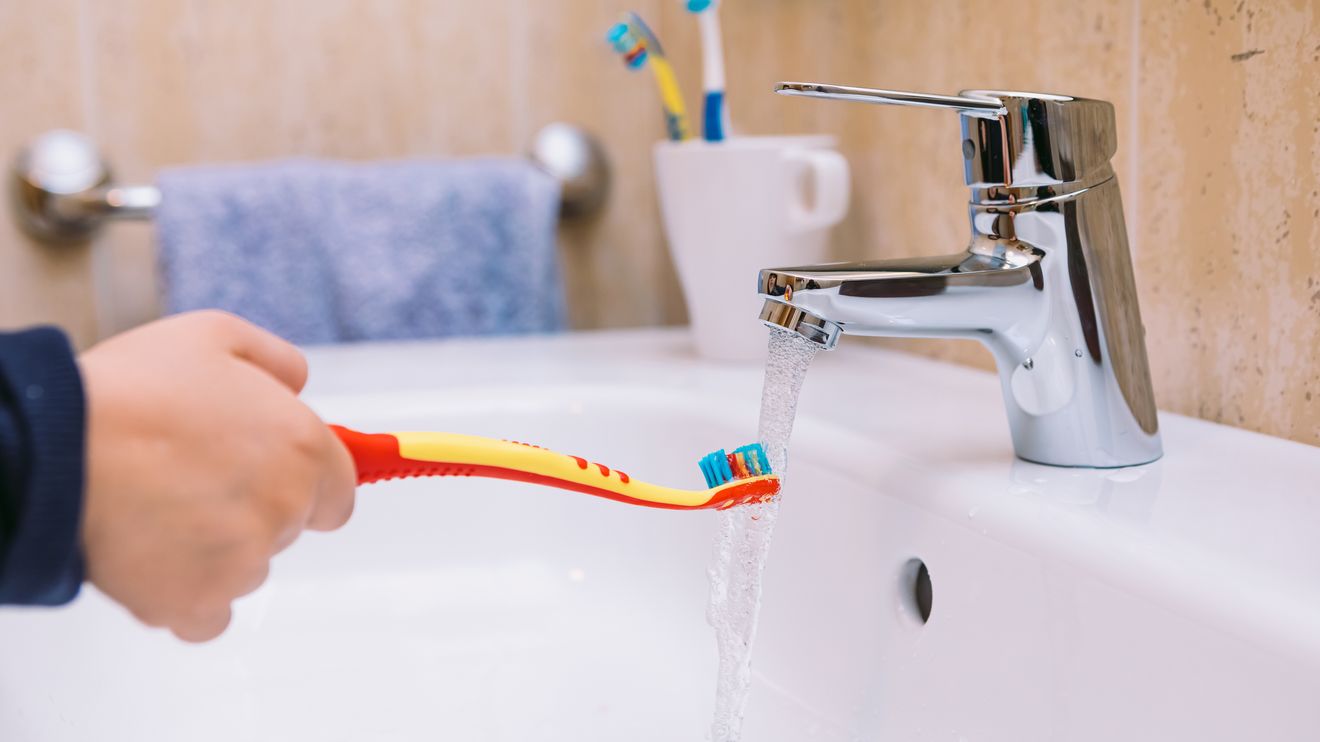A British dentist has gone viral for suggesting that wetting your toothbrush before applying toothpaste is a big no-no, which has got plenty of tongues wagging on social media. It also led Google searches about “tooth brushing” and “how to properly brush your teeth” to spike this week, which coincidentally happens to be the beginning of Oral Health Month.
Dr. Sahil Patel, a London-based dentist with the Marylebone Smile Clinic, shared his views on proper brushing technique in a recent story in the British press. Patel’s knock on pre-wetting the toothbrush is two-fold: First, he says it dilutes the toothpaste, which means that you’re not getting its full benefit, fluoride and all.
“Fluoride is only effective at a certain concentration,” Patel told MarketWatch.
And Patel points to another issue — namely, that by wetting the toothbrush, you’re likely making the toothpaste foamier, which may result in you spitting it out and ending your brushing routine much earlier than you should. After all, the American Dental Association (ADA) recommends brushing twice daily — and for two minutes at a time.
Patel says the ritual of wetting the toothbrush is really a carryover from the days when we relied on tooth powder, which was a precursor to toothpaste. And you needed to wet the brush to get the powder to stick. But because toothpaste can naturally adhere to your toothbrush, wetting the bristles is unnecessary today. But Patel concedes that the ritual just, well, cemented itself.
“The habit stuck,” he said.
Certainly, maintaining good dental hygiene is important in terms of avoiding problems, such as gum disease, dental experts advise. And that’s especially true at a time when Americans are spending more than ever to take care of their teeth and deal with dental issues.
In 2021, Americans spent a record $162 billion on dental care, according to the ADA. That figure is expected to reach $230 billion by 2030, according to one government report.
How does that break down? Filling a cavity costs around $150 on average, according to the ADA’s 2020 survey of dental fees, as reported by Forbes. Pulling a tooth can run up almost $200, and getting a crown put on comes in at nearly $1,300. And plenty of people are paying out-of-pocket: Some 77 million American adults did not have dental insurance last year, according to a survey on inequities in oral health care run by the nonprofit CareQuest Institute for Oral Health.
What’s more, a recent ADA poll found that three out of four dentists plan to raise their fees in 2023.
And the cost of neglecting your oral health can be even greater, as research has shown that gum disease and oral bacteria (which can result from not brushing your teeth and developing oral infections) have been linked to health complications such as heart disease, diabetes, dementia and stroke. Even baseball great Alex “A-Rod” Rodriguez is teaming up with OraPharma, a dental-care pharmaceutical firm that’s part of Bausch Health Companies
BHC,
to raise gum disease awareness after learning he’s suffering from it himself.
Read more: Baseball legend Alex Rodriguez’s new pitch: Raising awareness about gum disease
Patel’s advice not to pre-wet the toothbrush is resonating with some other dental practitioners.
“You’re reducing the efficacy of the toothpaste,” agreed Dr. Dani Benyaminy, a Los Angeles-based dentist. But Benyaminy does add one recommendation: You should rinse the toothbrush after brushing, “so there’s no bacteria sitting there.”
But others are not as convinced that pre-wetting is so bad.
“It’s a stretch for me,” said Dr. William Graves, a Texas-based dentist who serves as a faculty member with the Texas Tech Health Sciences Center School of Medicine in Amarillo. He added, “I’d have to have some study to back up” the pre-wetting concern.
There are also some dental professionals who argue that there’s an advantage to pre-wetting the toothbrush. The practice “adds moisture, and for most people, makes the experience more pleasant,” said Damien Walmsley of the British Dental Association.
And what do the big toothpaste brands have to say on the pre-wetting subject? Officials with Colgate
CL,
didn’t respond to a MarketWatch request for comment, but the brand devotes a whole page on its website to the matter. (In the end, the brand doesn’t weigh in, pro or con, but offers general advice on toothbrushing, via the ADA, including the benefits of using a brush with soft bristles.)
Officials with Crest
PG,
another major toothpaste brand, declined to comment for this story.
Of course, some regular folks have chimed in with their opinions on Twitter and other social-media outlets, even before Patel’s advice started getting passed around. Let’s just say there are some pretty strong opinions on the subject, as in this example:
But if there’s one thing that Dr. Patel and other dentists can agree on, it’s this: Regardless of whether you pre-wet your toothbrush or not, you should brush your teeth for two full minutes twice a day, as recommended by the ADA.
In fact, the ADA also offers very detailed directions on brushing your teeth:
- Step 1: Place the toothbrush at a 45-degree angle to the gums.
- Step 2: Move the brush back and forth gently in short strokes.
- Step 3: Brush the outer surfaces, the inside surfaces and chewing surfaces of all teeth.
- Step 4: To clean the inside surface of front teeth, tilt the brush vertically and make several up-and-down strokes.
- Step 5: Brush your tongue to remove bacteria and keep your breath fresh.
And don’t forget about cleaning between your teeth, too, whether that’s using dental floss or doing what the pros call “interdental cleaning” by using interdental brushes, oral irrigators or woodsticks to get in there.
Read the full article here


